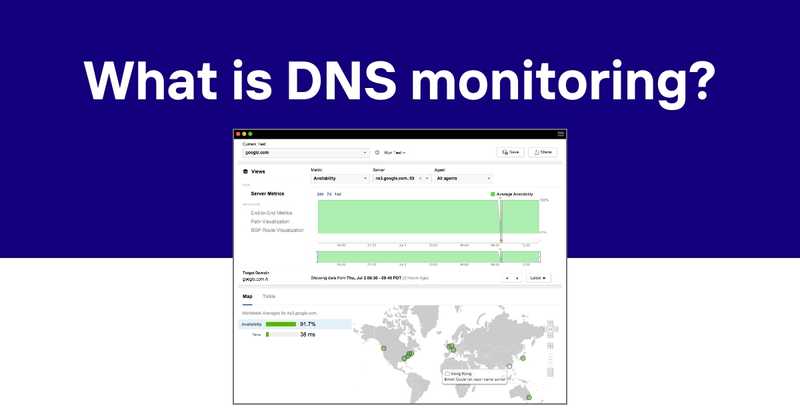What is DNS Monitoring?
DNS monitoring is a critical practice for maintaining the health, security, and performance of your online presence. As a software developer, understanding DNS monitoring is essential for ensuring your applications and services remain accessible and secure. This comprehensive guide will explore the ins and outs of DNS monitoring, its importance, and how to implement it effectively.
Table of Contents
- Understanding DNS
- The Importance of DNS Monitoring
- Key Components of DNS Monitoring
- Common DNS Issues and Attacks
- DNS Monitoring Tools and Techniques
- Best Practices for DNS Monitoring
- Interpreting DNS Monitoring Data
- DNS Monitoring and Website Performance
- Future Trends in DNS Monitoring
- Conclusion
Understanding DNS
Before diving into DNS monitoring, it's crucial to have a solid grasp of what DNS is and how it works. The Domain Name System (DNS) is often described as the internet's phonebook. It's a hierarchical, distributed database that translates human-readable domain names into IP addresses that computers use to identify each other on the network.
When you type a URL into your browser, a DNS query is initiated to resolve the domain name to an IP address. This process involves several steps:
- The browser checks its local cache for the IP address.
- If not found, it queries the operating system's DNS cache.
- If still not found, it sends a request to a DNS resolver, typically provided by the ISP.
- The resolver checks its cache and, if necessary, queries root servers, then Top-Level Domain (TLD) servers, and finally authoritative nameservers to get the IP address.
- The IP address is returned to the browser, which can then establish a connection with the web server.
This process happens in milliseconds, allowing for seamless browsing experiences. However, any disruption in this chain can lead to websites becoming inaccessible or, worse, users being directed to malicious sites.
The Importance of DNS Monitoring
DNS monitoring is the practice of regularly checking and analyzing DNS records and performance to ensure proper functionality and security. As a software developer, you might wonder why DNS monitoring should be on your radar. Here's why it's crucial:
-
Uptime and Availability: DNS issues can make your services unreachable even if your servers are running perfectly. Monitoring helps detect and resolve these issues quickly.
-
Security: DNS is a common target for attacks. Monitoring can help identify and mitigate threats like DNS cache poisoning or DNS hijacking.
-
Performance Optimization: Slow DNS resolution can significantly impact your application's performance. Monitoring helps identify and address latency issues.
-
Compliance: Many regulatory standards require continuous monitoring of critical infrastructure, including DNS.
-
Troubleshooting: When issues arise, DNS monitoring data can provide valuable insights for faster resolution.
-
Change Management: Monitoring helps track and verify DNS changes, ensuring that updates are applied correctly and consistently.
Key Components of DNS Monitoring
Effective DNS monitoring involves keeping track of several key components:
1. DNS Records
Monitoring various DNS record types is essential:
- A and AAAA Records: These map domain names to IPv4 and IPv6 addresses, respectively.
- CNAME Records: These create aliases for other domain names.
- MX Records: These specify mail servers for the domain.
- NS Records: These indicate which nameservers are authoritative for the domain.
- SOA Records: These contain administrative information about the DNS zone.
- TXT Records: These can hold various types of information, often used for security purposes like SPF records.
2. DNS Resolution Time
This measures how long it takes to resolve a domain name to an IP address. Slow resolution times can significantly impact user experience.
3. DNS Propagation
When you make changes to DNS records, it takes time for these changes to propagate across the internet. Monitoring this process ensures changes are applied correctly and universally.
4. Nameserver Performance
The performance of your authoritative nameservers is crucial. Monitoring their response times and availability helps maintain optimal DNS performance.
5. DNSSEC
If you've implemented DNSSEC (DNS Security Extensions), monitoring its proper functioning is vital for maintaining the security of your DNS infrastructure.
Common DNS Issues and Attacks
Understanding common DNS issues and attacks is crucial for effective monitoring. Here are some scenarios to watch out for:
DNS Cache Poisoning
This attack involves injecting false information into a DNS cache, potentially redirecting users to malicious sites. Regular monitoring of DNS responses can help detect unexpected changes that might indicate cache poisoning.
DNS Hijacking
In this attack, DNS queries are intercepted and altered to return incorrect IP addresses. Monitoring can help detect unexpected changes in DNS responses or unusual patterns in DNS traffic.
DDoS Attacks on DNS Infrastructure
Distributed Denial of Service (DDoS) attacks can overwhelm DNS servers, making them unable to respond to legitimate queries. Monitoring DNS traffic patterns and server performance can help identify and mitigate these attacks.
Misconfigurations
Human error in DNS configuration can lead to service outages or security vulnerabilities. Regular monitoring of DNS records can help catch these mistakes before they cause significant issues.
Expired Domains
If a domain used in your DNS configuration expires, it can lead to service disruptions. Monitoring domain expiration dates as part of your DNS monitoring strategy is crucial.
DNS Monitoring Tools and Techniques
There are various tools and techniques available for DNS monitoring. As a software developer, you might be interested in both third-party solutions and tools you can integrate into your own systems.
Third-Party DNS Monitoring Services
These services provide comprehensive DNS monitoring from multiple global locations. They can alert you to issues often before they impact your users. Some popular options include:
- DNSCheck
- Pingdom
- UptimeRobot
- Cloudflare DNS Analytics
Open-Source Tools
For developers who prefer more control or need to integrate DNS monitoring into their existing systems, several open-source tools are available:
- dig (Domain Information Groper): A flexible command-line tool for querying DNS servers.
- dnstracer: Traces a path through the DNS system to the authoritative nameserver for a given hostname.
- DNSPython: A DNS toolkit for Python that you can use to build custom DNS monitoring solutions.
Custom Monitoring Scripts
As a developer, you might want to create custom scripts tailored to your specific needs. These could involve:
- Periodic DNS queries to check resolution times and record consistency
- Comparing DNS responses from different locations
- Monitoring DNSSEC signatures and expiration dates
Integration with Monitoring Systems
DNS monitoring can be integrated into broader monitoring systems like Nagios, Zabbix, or Prometheus. This allows for centralized alerting and correlation with other system metrics.
Best Practices for DNS Monitoring
To get the most out of your DNS monitoring efforts, consider these best practices:
-
Monitor from Multiple Locations: DNS can behave differently depending on geographic location. Use monitoring nodes from various regions to get a comprehensive view.
-
Set Up Alerts: Configure alerts for critical issues like failed resolutions, unexpected record changes, or abnormal response times.
-
Regular Audits: Periodically review your DNS configuration to ensure it aligns with your current infrastructure and security policies.
-
Monitor All Critical Records: Don't just focus on A records. Monitor all record types that are crucial for your services, including MX, CNAME, and TXT records.
-
Track Changes: Implement a change management system for DNS records. This helps in troubleshooting and maintaining security.
-
Test DNS Security: Regularly test your DNS security measures, including DNSSEC if implemented.
-
Monitor Expiration Dates: Keep track of domain and SSL certificate expiration dates to prevent unexpected outages.
-
Implement Redundancy: Use multiple DNS providers or nameservers to improve resilience against outages or attacks.
-
Continuous Learning: Stay informed about DNS best practices and emerging threats. The DNS landscape is constantly evolving.
Interpreting DNS Monitoring Data
Collecting DNS monitoring data is only half the battle. The real value comes from interpreting this data to gain actionable insights. Here's how to make sense of common DNS monitoring metrics:
Resolution Time
- Normal Range: Typically under 100ms for efficient DNS setups.
- Warning Signs: Consistent increases in resolution time or sporadic spikes.
- Action Items: Investigate nameserver performance, consider using a CDN or anycast DNS for improved global performance.
Query Success Rate
- Normal Range: Should be close to 100% for a healthy DNS setup.
- Warning Signs: Any significant drop in success rate.
- Action Items: Check for misconfigurations, nameserver issues, or potential attacks.
Record Consistency
- Normal Behavior: Records should be consistent across all authoritative nameservers.
- Warning Signs: Discrepancies in records between different nameservers.
- Action Items: Review recent changes, check for zone transfer issues, verify nameserver configurations.
DNSSEC Validation
- Normal Behavior: All DNSSEC-signed records should validate successfully.
- Warning Signs: Failed validations or signature expirations.
- Action Items: Review DNSSEC configuration, check for expired or misconfigured signatures.
Traffic Patterns
- Normal Behavior: Consistent patterns with expected fluctuations based on usage.
- Warning Signs: Sudden spikes or drops in traffic, unusual query patterns.
- Action Items: Investigate for potential DDoS attacks, check for misconfigurations or application issues driving unexpected traffic.
DNS Monitoring and Website Performance
DNS performance is a critical factor in overall website performance. Here's how DNS monitoring ties into website optimization:
Impact on Page Load Times
DNS resolution is often the first step in loading a web page. Slow DNS can add significant latency to page load times, affecting user experience and potentially impacting search engine rankings.
Monitoring Strategies for Performance
-
Track Time to First Byte (TTFB): This metric includes DNS lookup time and can help identify DNS-related performance issues.
-
Monitor CDN Performance: If you're using a Content Delivery Network, monitor its DNS performance as well.
-
Analyze DNS Caching: Ensure your DNS TTL (Time to Live) settings are optimized for performance without sacrificing flexibility.
-
Geographical Performance: Use DNS monitoring from various locations to ensure consistent performance globally.
Optimizing DNS for Performance
Based on monitoring data, you can implement several optimizations:
- Use anycast DNS to reduce latency for global users.
- Implement DNS prefetching for commonly accessed domains.
- Optimize TTL settings based on how frequently your DNS records change.
- Consider using a managed DNS service with global points of presence.
Future Trends in DNS Monitoring
As the internet landscape evolves, so does the field of DNS monitoring. Here are some trends to watch:
AI and Machine Learning in DNS Monitoring
Machine learning algorithms can analyze vast amounts of DNS data to detect anomalies and predict potential issues before they occur. This proactive approach can significantly improve DNS security and performance.
DNS over HTTPS (DoH) and DNS over TLS (DoT)
These protocols encrypt DNS queries, improving privacy and security. Monitoring solutions will need to adapt to handle encrypted DNS traffic effectively.
IoT and DNS
The proliferation of Internet of Things (IoT) devices is putting new demands on DNS infrastructure. Monitoring solutions will need to scale to handle the increased load and unique challenges posed by IoT devices.
DNSSEC Adoption
As DNSSEC adoption grows, monitoring solutions will need to provide more comprehensive DNSSEC validation and troubleshooting capabilities.
Integration with Threat Intelligence
DNS monitoring is increasingly being integrated with broader threat intelligence platforms, providing more context around potential security issues.
Conclusion
DNS monitoring is a critical aspect of maintaining a robust, secure, and high-performing online presence. As a software developer, understanding the intricacies of DNS monitoring can help you build more resilient applications and troubleshoot issues more effectively.
By implementing comprehensive DNS monitoring, you can ensure that your services remain accessible, secure, and performant. Remember that DNS monitoring is not a set-it-and-forget-it task. It requires ongoing attention, regular reviews, and adaptation to new technologies and threats.
As you implement DNS monitoring in your projects, consider integrating it with your broader monitoring and alerting systems. This holistic approach will give you a more complete picture of your application's health and performance, allowing you to provide the best possible experience for your users.



